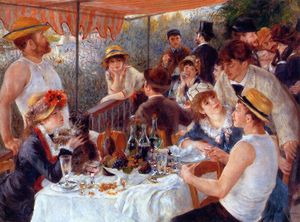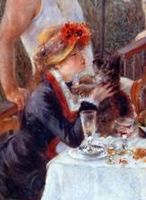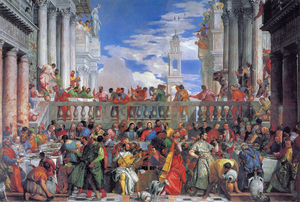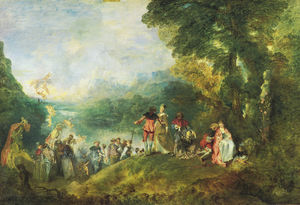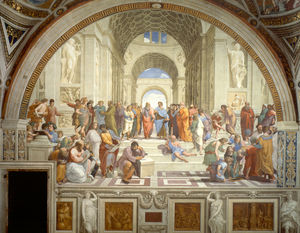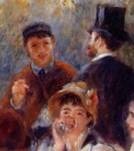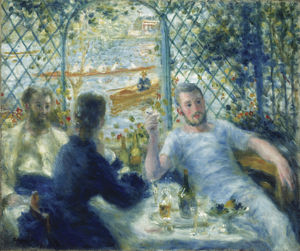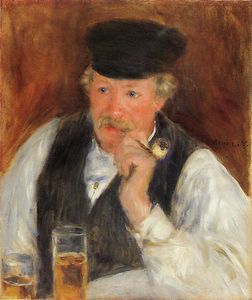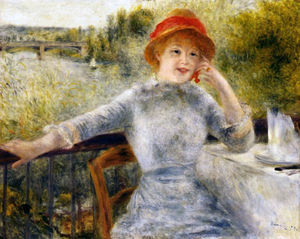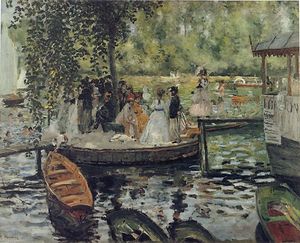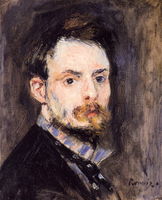Luncheon of the Boating Party
- Date of Creation:
- 1881
- Alternative Names:
- Le dejeuner des canotiers
- Height (cm):
- 130.20
- Length (cm):
- 175.60
- Medium:
- Oil
- Support:
- Canvas
- Subject:
- Scenery
- Framed:
- Yes
- Art Movement:
- Impressionism
- Created by:
- Current Location:
- Washington, District of Columbia
- Displayed at:
- Phillips Collection
- Owner:
- Phillips Collection
- Luncheon of the Boating Party Page's Content
- Story / Theme
- Inspirations for the Work
- Analysis
- Critical Reception
- Related Paintings
- Artist
- Art Period
- Bibliography
Luncheon of the Boating Party Story / Theme
Luncheon of the Boating Party is also known as Le déjeuner des canotiers and it was produced at the height of Renoir´s Impressionist career, in 1881. Luncheon of the Boating Party is one of Renoir´s final works depicting a sociable scene from his early life.
Luncheon of the Boating Party shows a group of Renoir´s friends relaxing and enjoying food, drinks and good conversation on a balcony at the Maison Fournaise in Chatou, France. Renoir often included close friends is his paintings and in this canvas he also includes his future wife, Aline Charigot, who can be seen in the left foreground playing with a small dog.
It seems that Renoir portrays his feelings for Aline by separating her from the others and she is the only cast member who does not engage in conversation or flirting but instead directs all of her attention at her dog. Renoir also reinforces Aline´s status in the painting by using brighter colors for some items of clothing.
In terms of other attendees, in the right foreground of the paintings wearing a straw hat is Gustave Caillebotte, one of Renoir's wealthier customers. Other participants include the artist Paul Lhote, the amateur art historian, collector, and editor of the Gazette des Beaux-Arts Charles Ephrussi, French poet Jules Laforgue, actresses Ellen Andree, Jeanne Samary and Angele Legault, former mayor of colonial Saigon Baron Raoul Barbier, the proprietor´s children Louise-Alphonsine Fournaise and Alphonse Fournaise Jr. , bureaucrat Eugene Pierre Lestringez, and Italian journalist Maggiolo.
Luncheon of the Boating Party is among Renoir´s most famous canvases and it is a true representation both this period of time and Impressionism.
Luncheon of the Boating Party Inspirations for the Work
It was in 1868 that Renoir first discovered Chatou and he instantly fell in love with it. After discovering the Restaurant Fournaise, Renoir became a regular guest. During his career, the artist painted no less than thirty canvasses in Chatou - many in the restaurant itself and other of the proprietor's family and the surrounding areas.
Luncheon of the Boating Party was intended to replicate everyday modern life and Renoir was eager to display his work at the official Salon Des Arts. However, the famous collector Paul Durand-Ruel purchased the canvas for the 7th Impressionist Exhibition instead, despite Renoir's wishes.
Many art historians suggest that Luncheon of the Boating Party was a response to a challenge printed in the June review of the official Salon exhibition of 1880 by famous writer and critic Emile Zola. Zola condemned the Impressionists saying: "they show their works while incomplete, illogical, exaggerated... " Zola dared the Impressionists to produce more completed and complicated modern-day paintings and so it could be the case that Renoir's ambitious project with Luncheon of the Boating Party, its lengthy execution and detailed arrangement are a response to Zola's challenge.
Others believe that Renoir created this painting as a direct response to the disbanding of the 'brotherhood' of French Impressionist artists such as Renoir, Monet, Caillebotte, Pissaro, Sisley, Cezanne and Marisot. It was around this time that Degas declared that these artists could not contribute work to both the official Salon and the separate Impressionist show which resulted in Renoir, Monet, Sisley and Cezanne being excluded.
As well as this, Degas was introducing new, younger artists to the Impressionist movement and so it could be that Renoir was keen to reinforce his status as one of the movement's greatest painters and therefore set about working on this canvas.
There are many other possible inspirations for Luncheon of the Boating Party given the fact that Renoir was so passionate about his work and drew inspiration from a variety of sources. The artists' admiration for the history of art and the works exhibited in the Louvre in Paris continued to motivate him throughout his career.
It's likely that for Luncheon of the Boating Party Renoir was influenced by Paolo Veronese's grand banquet scene, The Marriage Feast at Cana (1562-63). Renoir's canvas resonates the vivacious event depicted in Veronese's work and there are similarities with both compositions, with both showing a rectangular table filled with guests that stretches out toward the viewer.
Another source of inspiration in the Louvre was Jean-Antoine Watteau's Embarkation for Cythera (1717). During the 1860s and 1870s eighteenth century Rococo was well-liked and it was apparent in many aspects of French culture, from fashion to music. Renoir was a great fan of Watteau's portrayal of stylish, cheerful occasions such as picnics of the Rococo festive parties (fetes galantes) and he also studied Watteau's skillful use of gesture in detail.
Renoir's admiration for such artists was evidence of his confidence in the value of French artistic tradition and his role within it. Luncheon of the Boating Party is a painting with a great deal of charm that captures the true spirit of this particular moment in time.
In his composition Renoir blended various traditional categories of painting; still life, landscape, portraiture and genre. The finished product is a timeless masterpiece that successfully conveys the enchanting atmosphere of the Maison Fournaise, where a group of friends relax and enjoy good food and conversation on a Sunday afternoon.
Luncheon of the Boating Party Analysis
It took Renoir six months to complete Luncheon of the Boating Party and it has proven to be one of the artist's most adored paintings. This canvas shows the artist creatively using clothing and scenery to portray a typical sunny afternoon gathering of friends.
Composition:
Renoir skillfully uses shape, space, color and texture to create this scene. The figures and bottles add shape to the canvas and the overlapping of bodies gives a sense of space. Movement is achieved through the gesture and expression of the cast members.
Renoir made several compositional changes to Luncheon of the Boating Party, one of the biggest being the addition of the striped awning which works to further enforce the feeling of intimacy.
Renoir craftily uses shape, space, color, and texture to create the scene he imagined. The figures and bottles add shape to the canvas and the overlapping of bodies gives a sense of space.
There is no evidence suggesting that Renoir created any preparatory drawings for Luncheon of the Boating Party or that he made any preliminary sketches on the canvas. Instead he developed his compositions as he went along, a common Impressionist approach.
Color Palette:
Brimming with color this painting reflects both the time period and Impressionist style. Renoir's palette contains many golden tones and the women's fair skin is reddened from the sun.
Lighting:
There is a great deal of light throughout this composition, the main of light being the opening in the balcony. Sunlight is reflected by the table cloth and the vests of the two men in the foreground of the painting.
Luncheon of the Boating Party Critical Reception
Luncheon of the Boating Party is generally regarded as one of Renoir's early masterpieces but, like most of his works, it is not without its critics.
Initial Reception:
Comments from author and critic Emile Zola in particular could have prompted Renoir to create this canvas. Zola wrote a review of the Impressionist show and labeled the artists as a "sloppy, self-satisfied group of forerunners inferior to what they undertake". It could be that this painting was a way for Renoir to disprove Zola´s theory. To many people, Zola´s criticism was deemed ridiculous but it seems that Renoir took it to heart and was determined to create a masterpiece to disprove Zola´s theory.
It wasn't until 1883 that Renoir felt he could no longer continue with Impressionism but many believe that Luncheon of the Boating Party is already evidence of a changing style. With this and other works Renoir felt that his technique was becoming too loose and that the distinctiveness of the forms was being lost. To overcome this, he studied past works and visited Italy for inspiration and he was particularly impressed with the work of Raphael.
After Death:
In his analysis of Luncheon of the Boating Party , possibly Renoir's most famous and happy canvas, Theodore Duret questions whether this is a truly joyful painting. Duret argues that there are no real connections between the cast members. Although some people are smiling, no one in this painting looks at each other. The only two cast members who are exceptions from this rule are Aline Charigot, Renoir's future wife, and her dog, who look directly at each other.
Yet, despite such claims, Duret adds: "But one cannot imagine these women, as they are here, having been painted by anybody else. They have the free and easy manners one would expect of young women who have lunched and are enjoying themselves with a group of young men, but they also have that graciousness, that roguish charm, which Renoir alone could give to women."
Luncheon of the Boating Party Related Paintings
Luncheon of the Boating Party Artist
Renoir is an artist best known for his depictions of pleasant scenes, and curvy women. As a young painter he was influenced by a number of artists and artistic periods and this resulted in him developing an original technique which earned him his reputation as a 'pure impressionist. '
Renoir painted landscapes, portraits, still life, and modern life. He experimented with new methods throughout his career and dedicated his life to his art.
He was the first Impressionist to break away from the movement's ultramodern direction, yet many feel Renoir remained the purest of all the Impressionist painters throughout his career. He made several thousand paintings and their sensuality made his works some of the most famous and frequently-reproduced in the history of art.
This canvas was produced at the height of Renoir's Impressionist career and is one of his last works capturing a sociable, pleasant scene from his early life.
Luncheon of the Boating Party Art Period
Renoir, together with his classmates Monet, Sisley, and Bazille established the Impressionist movement. Taking art in a new direction, these young artists experimented with new techniques and were considered radicals of their time because they broke the rules of traditional forms of painting, and worked outside of the studio.
Although Impressionism in France began when several other painters were experimenting with plein-air painting, Renoir and his peers developed new techniques that defined the movement; their art was immediate, and it portrayed movement with sincere compositions and vivid colors.
Rejected by the Salon, they displayed their works in private exhibitions and gained support for their distinct, modern paintings. Their works were easily identifiable by their use of bright colors, visible brush strokes, and emphasis on light. Their style depicted subjects and landscapes naturally.
The emergence of Impressionism inspired many other artists of the time and throughout the 19th century and led the way for a variety of other movements, including Neo-impressionism, Post-impressionism, Fauvism, and Cubism.
Luncheon of the Boating Party Bibliography
Many books have been written about Renoir and this famous painting. Below are a bibliography and a selection of recommended works about this fascinating art genre and one of its leading figures.
Bibliography:
• Renoir: A Master of Impressionism
Gerhard Gruitrooy (2009)
• Renoir, My Father
Jean Renoir (1964)
Recommended reading:
• Impressionism: Art, Leisure, and Parisian Society
Professor Robert L. Herbert et al (1991)
• Impressionism: Origins, Practice, Reception
Belinda Thomson (2000)
• The Private Lives of the Impressionists
Sue Roe (2007)

